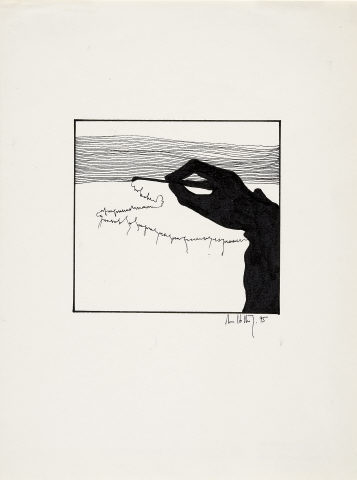
- 1975
- Paper
- Indian ink
- Inv. 04DP2003
Ana Hatherly
Metáfora da “mão inteligente”
Metáfora da “mão inteligente” (The “inteligent hand” metaphor), can be seen as a self-representation of Ana Hatherly through the drawing of her artistic and poetic hand, busy tracing with her brush a dense, and somewhat irregular, stave. The line diverges (or converges) at the point of contact with the brush, creating a second line, less docile, which deforms and zigzags in the composition of a continuous, illegible writing. This image arises as authorial symbol of a unique work, created from «a desire to investigate, research, scrutinize “o que o mundo não tem/ o que o mundo não diz/ o que o mundo não é”» [1]. Or, as Ana Hatherly would write elsewhere, «o poema é para ver-se/ ler-se/ ouvir-se/ mas sobretudo adivinhar-se./ o poeta é uma sombra/ um perfil/ um desaparecimento/ mas sobretudo/ a despedida mão feita poema.»[2]
The poetic, literary, visual, cinematographic, academic, essayistic work of the author is surprisingly coherent in the diversity of lines pursued and achieved work. Her creative path, initiated in poetry in the late 1950s, would extend into other media and languages in the 1960s, as a result of her interest in concretism and experimentalism, which reveal to her the visual dimension of the text – focusing, in the Portugal of the decade prior to the revolution of 25th April 1974, on the compounded taste for the practice of subversion in the realm of writing, grounded in a network of international contacts and in a selective return to the past, namely to the literature of the mannerist-baroque period. Equally fundamental in her work will be the study of Zen Buddhism, conspicuous in Tisanas [3], and of archaic Chinese calli– graphy, which she repeats exhaustively in her training of the “intelligent hand”,[4] interested in «the knowledge of the creative act and its gratuitous nature».[5]
The poems and the created visual texts, the anagrams – her first solo show in 1969 was entitled Anagramas – the calligrams, gloss a poetic and meditative stance towards writing. «These are not works to be read, these are works to be seen»[6] for the most part made in Indian ink on paper, and integrating the white of the paper in the same way that the visual poems inscribe the silences of their vocalization. In its linkage of worlds habitually proximate, but parallel, such as that of poetry and that of drawing (painting), Ana Hatherly’s work coerces, in the elegance which it sets on the reproduced drawing, the word into line and the line into word.
Ana Vasconcelos
May 2010
1 “what the world does not contain/ what the world does not say/ what the world is not”, in Pedro Sena-Lino, Interfaces do Olhar, Lisboa, Roma Editora, 2004, p. 139.
2 “the poem is to be seen/ to be read/ to be heard/ but above all to be guessed./ the poet is a shadow/ a profile/ a vanishing/ but above all/ the dismissed hand become a poem”, in O Cisne Intacto, Porto, Limiar, 1983. 3 Short poems in prose published from the 1960’s until the present.
4 The expression “mão inteligente” was coined by the artist herself, in a text published in Mapas da Imaginação e da Memória, Lisbon, Moraes, 1973, p. 5.
5 Ibidem.
6 Pedro Sena-Lino, op. cit., p. 14.
| Type | Value | Unit | Section |
| Width | 15,9 | cm | |
| Height | 22,1 | cm |
| Type | date |
| Type | signature |
| Type | date |
| Type | A definir |
| Ana Hatherly: dessins, collages et papiers peints |
| Paris, 2005 |
| ISBN:972-635-170-7 |
| Catálogo de exposição |
| Ana Hatherly: dessins, collages et papiers peints |
| Centre Culturel Calouste Gulbenkian |
| Curator: Ana Vasconcelos e Melo |
| 6 de Outubro de 2005 a 15 de Dezembro de 2005 Centre Culturel Calouste Gulbenkian, Paris |
| Exposição de trabalhos de pequeno formato de Ana Hatherly, comissariada por Ana Vasconcelos. |
| Caligrafias : Uma Realidade Inquieta |
| Fundação Portuguesa das Comunicações |
| Curator: Maria João Fernandes |
| 9 de Outubro de 2008 a 15 de Janeiro de 2009 Lisboa, Fundação Portuguesa das Comunicações |
| A exposição inaugurou dia 9 de Outubro de 2008, integrando as várias acções preparadas por ocasião das comemorações do Dia Mundial dos Correios. |